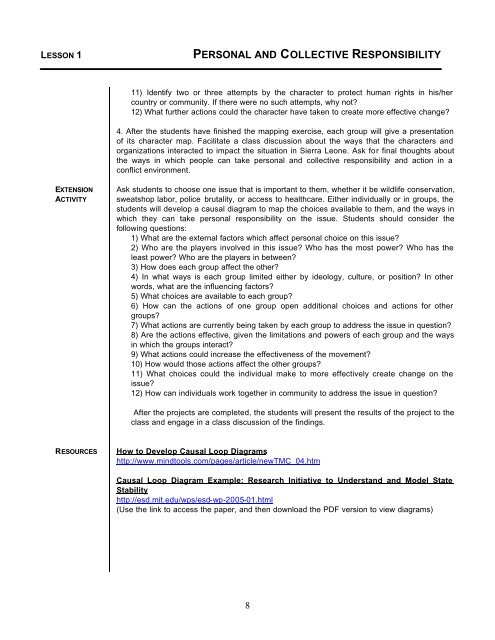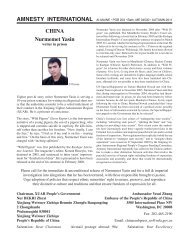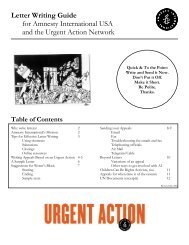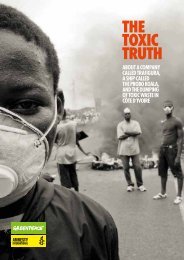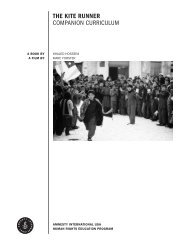Blood Diamond Curriculum Guide (PDF) - Amnesty International USA
Blood Diamond Curriculum Guide (PDF) - Amnesty International USA
Blood Diamond Curriculum Guide (PDF) - Amnesty International USA
You also want an ePaper? Increase the reach of your titles
YUMPU automatically turns print PDFs into web optimized ePapers that Google loves.
LESSON 1 PERSONAL AND COLLECTIVE RESPONSIBILITY<br />
EXTENSION<br />
ACTIVITY<br />
RESOURCES<br />
11) Identify two or three attempts by the character to protect human rights in his/her<br />
country or community. If there were no such attempts, why not?<br />
12) What further actions could the character have taken to create more effective change?<br />
4. After the students have finished the mapping exercise, each group will give a presentation<br />
of its character map. Facilitate a class discussion about the ways that the characters and<br />
organizations interacted to impact the situation in Sierra Leone. Ask for final thoughts about<br />
the ways in which people can take personal and collective responsibility and action in a<br />
conflict environment.<br />
Ask students to choose one issue that is important to them, whether it be wildlife conservation,<br />
sweatshop labor, police brutality, or access to healthcare. Either individually or in groups, the<br />
students will develop a causal diagram to map the choices available to them, and the ways in<br />
which they can take personal responsibility on the issue. Students should consider the<br />
following questions:<br />
1) What are the external factors which affect personal choice on this issue?<br />
2) Who are the players involved in this issue? Who has the most power? Who has the<br />
least power? Who are the players in between?<br />
3) How does each group affect the other?<br />
4) In what ways is each group limited either by ideology, culture, or position? In other<br />
words, what are the influencing factors?<br />
5) What choices are available to each group?<br />
6) How can the actions of one group open additional choices and actions for other<br />
groups?<br />
7) What actions are currently being taken by each group to address the issue in question?<br />
8) Are the actions effective, given the limitations and powers of each group and the ways<br />
in which the groups interact?<br />
9) What actions could increase the effectiveness of the movement?<br />
10) How would those actions affect the other groups?<br />
11) What choices could the individual make to more effectively create change on the<br />
issue?<br />
12) How can individuals work together in community to address the issue in question?<br />
After the projects are completed, the students will present the results of the project to the<br />
class and engage in a class discussion of the findings.<br />
How to Develop Causal Loop Diagrams<br />
http://www.mindtools.com/pages/article/newTMC_04.htm<br />
Causal Loop Diagram Example: Research Initiative to Understand and Model State<br />
Stability<br />
http://esd.mit.edu/wps/esd-wp-2005-01.html<br />
(Use the link to access the paper, and then download the <strong>PDF</strong> version to view diagrams)<br />
8


